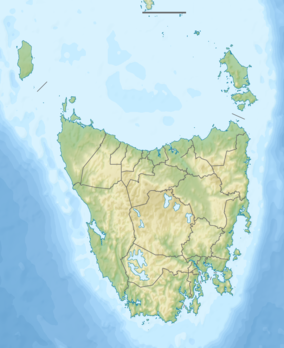| Lake Binney Dam | |
|---|---|
 | |
 Location of Lake Binney in Tasmania | |
| Country | Australia |
| Location | Central Highlands, Tasmania |
| Coordinates | 42°15′36″S 146°29′24″E / 42.26000°S 146.49000°E |
| Purpose | Power |
| Status | Operational |
| Opening date | 1953 |
| Owner(s) | Hydro Tasmania |
| Dam and spillways | |
| Type of dam | Embankment dam |
| Impounds | Big Marsh Creek |
| Height | 10 metres (33 ft) |
| Length | 1,262 metres (4,140 ft) |
| Dam volume | 192 thousand cubic metres (6.8×106 cu ft) |
| Spillways | 0 |
| Reservoir | |
| Creates | Tungatinah Lagoon |
| Total capacity | 26,420 megalitres (933×106 cu ft) |
| Catchment area | 52 square kilometres (20 sq mi) |
| Surface area | 40.9 hectares (101 acres) |
| Tungatinah Power Station | |
| Coordinates | 42°17′49″S 146°27′24″E / 42.29694°S 146.45667°E |
| Operator(s) | Hydro Tasmania |
| Commission date | 1953–1956 |
| Type | Conventional |
| Hydraulic head | 290 metres (950 ft) |
| Turbines | 5 x 25-megawatt (34,000 hp) Boving Francis-type turbine |
| Installed capacity | 125 megawatts (168,000 hp) |
| Capacity factor | 0.8 |
| Annual generation | 579 gigawatt-hours (2,080 TJ) |
| Website hydro | |
| [1] | |
The Tungatinah Power Station is a conventional hydroelectric power station located in the Central Highlands region of Tasmania, Australia. The power station is situated on the Upper River Derwent catchment and is owned and operated by Hydro Tasmania.
Technical details

Part of the Derwent scheme that comprises eleven hydroelectric power stations, the Tungatinah Power Station is the second station in the scheme, adjacent to the Nive River. The power station is located aboveground adjacent to the Nive River. The headworks are quite complex with several dams (including the Bronte Lagoon formed by Bronte Dam, Bradys Lake formed by Bradys Dam, Lake Binney and the Tungatinah Lagoon), a tunnel, canals, pipelines, flumes their associated control gates and a pump station. Water is diverted from the Tungatinah Lagoon by a short tunnel with surge shaft and then descends 290 metres (950 ft) through five steel penstocks to the power station.[2][3]
The power station was commissioned between 1953 and 1956 by the Hydro Electric Corporation (TAS) and the station has five Boving Francis turbines, with a total generating capacity of 125 megawatts (168,000 hp) of electricity.[4] Within the station building, each turbine has a semi-embedded spiral casing and water flow is controlled via a spherical rotary inlet valve and a relief valve designed to prevent spiral casing over pressure. The station output, estimated to be 579 gigawatt-hours (2,080 TJ) annually,[1] is fed to TasNetworks' transmission grid via five 11 kV/110 kV three-phase GEC generator transformer to the outdoor switchyard.[2]
After passing through the five turbines, water is discharged into the Nive River where it combines with the water from the Tarraleah Power Station to supply the six Lower Derwent stations.[3]
See also
References
- 1 2 "Register of Large Dams in Australia". Dams information. Australian National Committee on Large Dams. 2010. Archived from the original (Excel (requires download)) on 12 December 2013. Retrieved 23 June 2015.
- 1 2 "Tungatinah Station: Technical fact sheet" (PDF). Derwent Catchment. Hydro Tasmania. Archived from the original (PDF) on 24 September 2015. Retrieved 5 July 2015.
- 1 2 "Derwent: Tungatinah Power Station". Energy. Hydro Tasmania. Retrieved 5 July 2015.
- ↑ Austral Archaeology Pty Ltd; Terry, Ian (April 2007). "Tungatinah Power Station—Conservation Management Plan" (PDF). Retrieved 1 February 2012.
External links
- Hydro Tasmania page on the Lower Derwent Archived 19 September 2006 at the Wayback Machine